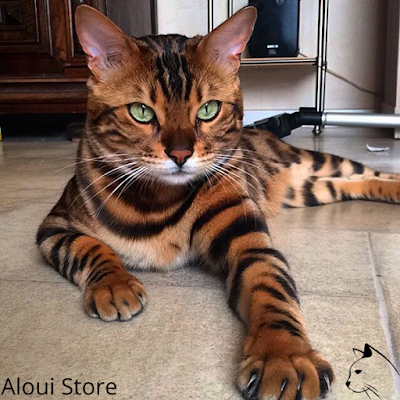They are known for their distinctive coat patterns, which range from marbled to spot, and their athletic and energetic personalities.
Bengal cats are highly intelligent and playful, and they make excellent pets for those who enjoy an active, engaging feline companion.
Peruse beneath with Alouistore for a total rundown of Bengal feline variety attributes!
 |
| Bengal cat |
1- History
The Bengal cat breed was created by breeding an Asian leopard cat with a domestic cat.Bengal felines are so searched, that a British lady paid over $50,000 for her Bengal feline in 1990, naming them the "Moves Royce" of cat allies.
2-Size
Bengal cats are a medium-sized breed of domestic cat, typically weighing between 7 to 15 pounds. Males tend to be larger than females and can reach weights of up to 20 pounds.3-Personality
Bengal cats are known for their playful, energetic, and curious personalities.Also read: savannah cat
4-Health
Bengal cats are generally a healthy breed, with a lifespan of 12 to 15 years. However, like all breeds, they are prone to certain health issues. Some of the health concerns to watch out for in Bengal cats include:
- Hypertrophic cardiomyopathy (HCM): A common heart condition in cats that can lead to heart failure.
- Kidney disease: Bengal cats are prone to developing chronic kidney disease, especially as they age.
- Obesity: Bengal cats are prone to obesity due to their tendency to overeat and lack of exercise.
- Feline diabetes: Bengal cats are prone to developing feline diabetes, especially if they are overweight.
It is important to maintain regular vet check-ups and to monitor your Bengal cat's weight and diet to help prevent these health issues. With proper care and attention, Bengal cats can live long, healthy lives.
Read more: pharaoh cat (sphynx cats)
5-Care
Here are some important care tips for Bengal cats:- Diet: Feed your Bengal cat a balanced, nutritious diet to maintain their health and prevent obesity. Offer a mixture of wet and dry food, and avoid overfeeding.
- Exercise: Bengal cats are highly active and energetic, so it's important to provide plenty of toys and opportunities for play and exercise. Consider investing in a cat tree or other climbing structure, and provide interactive toys such as puzzle feeders.
- Grooming: Bengal cats have a short, dense coat that requires minimal grooming, but they do shed. Regular brushing can help to remove loose fur and reduce shedding.
- Mental stimulation: Bengal cats are intelligent and curious, so it's important to provide plenty of mental stimulation to prevent boredom. Consider providing puzzle toys, hiding treats, and offering interactive play sessions.
- Regular vet check-ups: Regular vet check-ups are important for maintaining your Bengal cat's health and detecting any potential health issues early.
6-Fur color and outline
- Coat pattern: Bengal cats have a distinctive coat pattern that ranges from marbled to spot. Their coats are usually covered in bold, contrasting stripes and spots, creating a distinctive appearance that resembles that of wild big cats like leopards and jaguars.
- Coat color: Bengal cats come in a variety of coat colors, including brown, black, silver, blue, and melanistic (black). The background color of their coats can range from cream to golden to orange to red, with their spots and stripes being a contrasting color.
- Glitter: Many Bengal cats have a unique feature known as "glitter," where their coats shimmer and sparkle in the light. This is due to a unique quality in their fur that reflects light, creating a metallic appearance.
Also read: British Shorthair cat
7-Children And Other Pets
The active and social Bengal may be a perfect choice for families with children and cat-friendly dogs. He will play fetch also as any retriever, learns tricks easily, and loves the eye he receives from children who treat him politely and with respect.
He’s smart enough to urge out of the way of toddlers but loves school-age children because they're a match for his energy state and curiosity.
Nothing scares him, never dogs, and he will happily make friends with them if they don’t give him any trouble. Always introduce any pets, even other cats, slowly and in a controlled setting.
Like many active cats, Bengals have a high prey drive and will not be trusted with smaller prey animals such as hamsters, smaller rabbits, and guinea pigs.